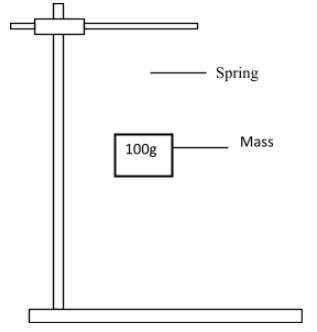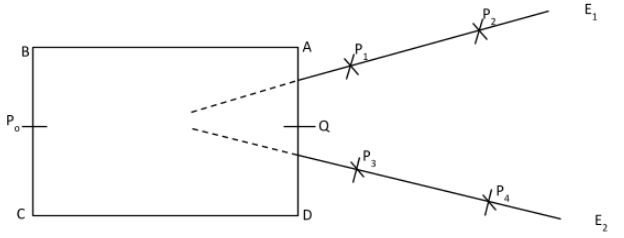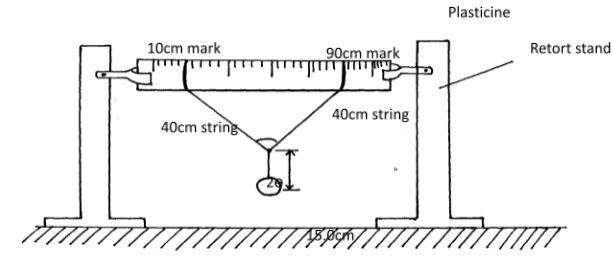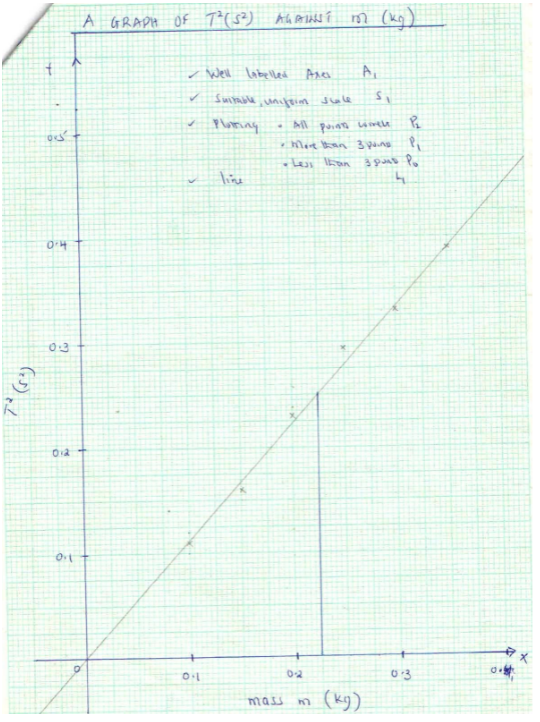INSTRUCTIONS TO CANDIDATES
- Answer ALL the questions
- You are supposed to spend the first 15 minutes of the 2 1/4 hours allowed for this paper reading the whole paper carefully before commencing your work.
- Marks are given for clear record of observations made, their suitability, accuracy and the use made of them.
- Candidates are advised to record their observations as soon as they are made.
- Non-programmable silent electronic calculators and KNEC mathematical table may be used.
PART A
- You are provided with the following:
- A retort stand, clamp and boss.
- A spiral spring.
- A stop watch.
- Three 100g masses.
- Three 50g masses.
PROCEDURE- Suspend a 100g mass at the end of a spiral spring as shown below.
- Now give the mass a small vertical displacement and release so that it performs vertical oscillation.
- Time for 20 oscillations and determine the period.
Enter the result in the table below. - Repeat the experiment for other values of mass given and complete the table.
6marksMass m(g) 100 150 200 250 300 350 Time for 20 oscillations t (s) Period time T (s) T² (S²) - Plot a graph of T² (S²) (y –axis) against m (kg). (5marks)
- Determine the slope of the graph. (2marks)
- Given that T2=2mwhere k is the spring constant , use the graph to obtain the value of the spring constant k. (2marks)
PART B
You are provided with the following- 5 optical pins
- A rectangular glass block
- A plain paper
- A soft board
- 4 thumb pins
Proceed as follows
- Fix the white piece of paper on the soft board using thumb pins. Place the glass block on the white paper and draw the outline of the block.
- Remove the glass block and indicate the sides A, B, C and D as shown.
- On side BC, determine its center and fix a pin P0 as shown. Looking from one side at the opposite end of the slab, fix pin P1 and then pin P2 so that they are in line with the image I of the pin P0 .On the other side locate the same image using pins P3 and P4 as shown above.
- Remove the glass block and the pins and produce lines P1P2 and P3P4 to their points of intersection; (the position of the image I) (1mark)
- Determine the midpoint of AD and label it Q. Measure the lengths QP0 and Q1. (2marks)
QP0 =..............................cm
Q1 =.................................cm - Work out the ratio =QPO =n (1mark)
Q1 - What does n represent (1mark)
- Suspend a 100g mass at the end of a spiral spring as shown below.
- You are provided with the following;-
- two retort stands
- a metre rule
- some cotton thread (approximately 1.2m long)
- a ball of plasticine
- a stop watch
- a protractor
- half metre rule
Proceed as follows:-
- Attach one end of a string to the metre rule at 10cm by fastening a loop of string tightly round the metre rule. Fix the string at this point with a small piece of plasticine. Tie the other end of the string around the metre rule at the 90cm mark. Fix this loop with another small piece of plasticine.
- Attach the pendulum bob to the centre of the string so that the centre of gravity of the bob is 15.0cm below the point of suspension (see figure below)
marks: refix the plasticine
measure the angle 2Ө and period T, as before. - Repeat (ii) above with the loops at 15cm and 85cm, 20cm and 80cm, 25cm and 75cm , 30cm and 70cm, 35cm and 65cm
- Enter all your results in the table below: (7mks)
Position of loop 2θ Cos θ Time , t for 10 oscillations Period, T (sec) T2(S2) 10cm and 90cm 12cm and 88cm 15cm and 85cm 20cm and 80cm 25cm and 75cm 30cm and 70cm 35 cm and 65cm
-
- On the grid provided plot a graph of T2(S2) (y-axis) against Cosθ (5mks)
- Find the intercept on the T2-axis (1mk)
- Determine the slope of your graph (2mks)
-
- Measure the angle 2θ
- Pull the pendulum towards you through a small distance, releases it and measure the period, T for motion by timing 10complete oscillations
- Remove the pasticine slide the loops to the 12cm and 88cm
-
- Measure the length, L, of the pendulum when 2θ= 0° in metres (1mk)
- From your graph, determine the period T of the pendulum when
2θ = 0° (2mks) - Using the formula T =2πl/g determine the value of ‘g’ given that T= 2.0 (2mks)
-

Marking Scheme
-
Mass m(g) 100 150 200 250 300 350 Time for 20 oscillations t (s) 6.59 8.03 9.60 10.91 11.57 12.56 Period time T (s) 0.3295 0.4015 0.4800 0.5455 0.5785 0.6280 T² (S²) 0.1086 0.1612 0.2304 0.2976 0.3347 0.3944
- For t each correct value ½mk max 3mks
- For T all values correct 2mks more than 3 correct
1mk less than three correct 0mk. max 2mks - For T² all values correct 1mk max 1mk
-
- Gradient = ∆Y = ∆T² = 0.25-0 ✔1 =1.111 s²/kg ✔¹
∆X ∆m 0.225-0 - y = mx +c
T²=π² M+0 =Slope=π²
K K
K= π² ✔ = π² = 8.972N/m ✔
slope 1.11 - Lines P1P2 & P3P4 intersecting at I ✔
- QP0 = 10.0cm✔
Q1= 6.6 cm✔ - n = QP0 = 10.0 = 1.5152✔
QI 6.6 - Refractive index✔
-
-
Position of loop 2θ θ Cos θ Time , t for 10 oscillations Period, T (sec) T2(S2) 10cm and 90cm 165° 82.5° 0.1305 0.917 0.917 0.841 12cm and 88cm 133° 66.5° 0.3987 1.135 1.135 1.288 15cm and 85cm 120° 60° 0.50 1.190 1.190 1.416 20cm and 80cm 97° 48.5° 0.6626 1.303 1.303 1.698 25cm and 75cm 78° 39° 0.771 1.370 1.370 1.877 30cm and 70cm 60° 30° 0.8660 1.420 1.420 2.016 35 cm and 65cm 45° 22.5° 0.9239 1.470 1.470 2.161 -
- Plotting – atleast 5pts correctly plotted (2mks)
3 or 4 pts (1mk)
Axes 1mk
Scale 1mk
Line(1mk - Intercept – 0.63, 0.252(1mk)
- Gradient =
- Plotting – atleast 5pts correctly plotted (2mks)
-
- L=0.55m
T2 = 2.2s2
T = 1.483s - T=2πl/g
T2 = 4π2. l/g
2.2 = 0.55 x 4π2
g
g=9.87
- L=0.55m
-

CONFIDENTIAL
QUESTION 1
Each candidate will require the following
- A retort stand, clamp and boss
- A spiral spring (k= 10 N /m)
- A stop watch
- Three 100g masses
- Three 50g masses
- 5 optical pinS
- A rectangular glass block (100x 60x 18 mm)
- A white plain paper
- A soft board
- 4 thumb pins
QUESTION 2
Each candidate should be provided with
- Two retort stands
- a metre rule
- some cotton thread (approximately 1.2m long)
- a ball of plasticine
- a stop watch
- a protractor
- half metre rule
Download Physics Paper 3 Questions and Answers with confidential - Form 3 End Term 1 Exams.
Tap Here to Download for 50/-
Get on WhatsApp for 50/-
Why download?
- ✔ To read offline at any time.
- ✔ To Print at your convenience
- ✔ Share Easily with Friends / Students





